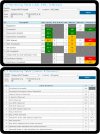Electronic data collection for multi-country, hospital-based, clinical observation of maternal and newborn care: EN-BIRTH study experiences
- PMID: 33765951
- PMCID: PMC7995708
- DOI: 10.1186/s12884-020-03426-5
Electronic data collection for multi-country, hospital-based, clinical observation of maternal and newborn care: EN-BIRTH study experiences
Abstract
Background: Observation of care at birth is challenging with multiple, rapid and potentially concurrent events occurring for mother, newborn and placenta. Design of electronic data (E-data) collection needs to account for these challenges. The Every Newborn Birth Indicators Research Tracking in Hospitals (EN-BIRTH) was an observational study to assess measurement of indicators for priority maternal and newborn interventions and took place in five hospitals in Bangladesh, Nepal and Tanzania (July 2017-July 2018). E-data tools were required to capture individually-linked, timed observation of care, data extraction from hospital register-records or case-notes, and exit-survey data from women.
Methods: To evaluate this process for EN-BIRTH, we employed a framework organised around five steps for E-data design, data collection and implementation. Using this framework, a mixed methods evaluation synthesised evidence from study documentation, standard operating procedures, stakeholder meetings and design workshops. We undertook focus group discussions with EN-BIRTH researchers to explore experiences from the three different country teams (November-December 2019). Results were organised according to the five a priori steps.
Results: In accordance with the five-step framework, we found: 1) Selection of data collection approach and software: user-centred design principles were applied to meet the challenges for observation of rapid, concurrent events around the time of birth with time-stamping. 2) Design of data collection tools and programming: required extensive pilot testing of tools to be user-focused and to include in-built error messages and data quality alerts. 3) Recruitment and training of data collectors: standardised with an interactive training package including pre/post-course assessment. 4) Data collection, quality assurance, and management: real-time quality assessments with a tracking dashboard and double observation/data extraction for a 5% case subset, were incorporated as part of quality assurance. Internet-based synchronisation during data collection posed intermittent challenges. 5) Data management, cleaning and analysis: E-data collection was perceived to improve data quality and reduce time cleaning.
Conclusions: The E-Data system, custom-built for EN-BIRTH, was valued by the site teams, particularly for time-stamped clinical observation of complex multiple simultaneous events at birth, without which the study objectives could not have been met. However before selection of a custom-built E-data tool, the development time, higher training and IT support needs, and connectivity challenges need to be considered against the proposed study or programme's purpose, and currently available E-data tool options.
Keywords: Birth; Data management; Electronic data collection tools; Electronic health records; Hospital records; Maternal; Newborn; Observation; Software.
Conflict of interest statement
The authors declare that they have no competing interests.
Figures
References
-
- UNICEF. The state of the World’s children 2019: statistical tables, 2019. New York: UNICEF; 2019. https://www.unicef.org/reports/state-of-worlds-children-2019. Accessed 9 Nov 2020.
-
- Alkema L, Chou D, Hogan D, Zhang S, Moller A-B, Gemmill A, et al. Global, regional, and national levels and trends in maternal mortality between 1990 and 2015, with scenario-based projections to 2030: a systematic analysis by the UN maternal mortality estimation inter-agency group. Lancet. 2016;387(10017):462–474. doi: 10.1016/S0140-6736(15)00838-7. - DOI - PMC - PubMed
-
- World Health Organization. Trends in maternal mortality 2000 to 2017: estimates by WHO, UNICEF, UNFPA, World Bank Group and the United Nations population division; 2019. https://www.unfpa.org/featured-publication/trends-maternal-mortality-200.... Accessed 9 Nov 2020.
-
- Bohren MA, Mehrtash H, Fawole B, Maung TM, Balde MD, Maya E, et al. How women are treated during facility-based childbirth in four countries: a cross-sectional study with labour observations and community-based surveys. Lancet. 2019;394(10210):1750–1763. doi: 10.1016/S0140-6736(19)31992-0. - DOI - PMC - PubMed
Publication types
MeSH terms
LinkOut - more resources
Full Text Sources
Other Literature Sources
Medical
Research Materials
Miscellaneous




